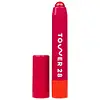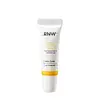What's inside
What's inside
 Key Ingredients
Key Ingredients

 Benefits
Benefits

 Concerns
Concerns

 Ingredients Side-by-side
Ingredients Side-by-side

Octyldodecanol
EmollientDiisostearyl Malate
EmollientBis-Diglyceryl Polyacyladipate-2
EmollientPolybutene
Polyethylene
AbrasivePentaerythrityl Tetraisostearate
EmollientCaprylic/Capric Triglyceride
MaskingButyrospermum Parkii Butter
Skin ConditioningMica
Cosmetic ColorantSynthetic Beeswax
Emulsion StabilisingGlyceryl Caprylate
EmollientPhenoxyethanol
PreservativePentaerythrityl Tetra-Di-T-Butyl Hydroxyhydrocinnamate
AntioxidantSclerocarya Birrea Seed Oil
HumectantTocopheryl Acetate
AntioxidantTocopherol
AntioxidantHelianthus Annuus Seed Oil
EmollientCI 77891
Cosmetic ColorantIron Oxides
CI 15850
Cosmetic ColorantOctyldodecanol, Diisostearyl Malate, Bis-Diglyceryl Polyacyladipate-2, Polybutene, Polyethylene, Pentaerythrityl Tetraisostearate, Caprylic/Capric Triglyceride, Butyrospermum Parkii Butter, Mica, Synthetic Beeswax, Glyceryl Caprylate, Phenoxyethanol, Pentaerythrityl Tetra-Di-T-Butyl Hydroxyhydrocinnamate, Sclerocarya Birrea Seed Oil, Tocopheryl Acetate, Tocopherol, Helianthus Annuus Seed Oil, CI 77891, Iron Oxides, CI 15850
Petrolatum
EmollientIsopropyl Palmitate
EmollientPolybutene
Caprylic/Capric Triglyceride
MaskingPentaerythrityl Tetraisostearate
EmollientPolyethylene
AbrasiveMicrocrystalline Wax
Emulsion StabilisingTocopheryl Acetate
AntioxidantButyrospermum Parkii Butter
Skin ConditioningSqualane
EmollientPanthenol
Skin ConditioningDiisostearyl Malate
EmollientAllantoin
Skin ConditioningSorbitan Sesquioleate
EmulsifyingPhenoxyethanol
PreservativeHydrogenated Vegetable Oil
EmollientPrunus Amygdalus Dulcis Oil
Skin ConditioningArgania Spinosa Kernel Oil
EmollientSimmondsia Chinensis Seed Oil
EmollientCamellia Sinensis Seed Oil
HumectantCamellia Japonica Seed Oil
EmollientOlea Europaea Fruit Oil
MaskingMacadamia Integrifolia Seed Oil
Skin ConditioningStearalkonium Hectorite
Gel FormingPropylene Carbonate
SolventCitrus Aurantium Dulcis Peel Oil
MaskingLimonene
PerfumingMonascus Extract
Skin ConditioningPalmitoyl Hexapeptide-12
Skin ConditioningTocopherol
AntioxidantWater
Skin ConditioningGlycyrrhetinic Acid
Skin Conditioning1,2-Hexanediol
Skin ConditioningSodium Hyaluronate
HumectantHydroxypropyltrimonium Hyaluronate
Hydrolyzed Hyaluronic Acid
HumectantSodium Acetylated Hyaluronate
HumectantHyaluronic Acid
HumectantPotassium Hyaluronate
Skin ConditioningSodium Hyaluronate Crosspolymer
HumectantPetrolatum, Isopropyl Palmitate, Polybutene, Caprylic/Capric Triglyceride, Pentaerythrityl Tetraisostearate, Polyethylene, Microcrystalline Wax, Tocopheryl Acetate, Butyrospermum Parkii Butter, Squalane, Panthenol, Diisostearyl Malate, Allantoin, Sorbitan Sesquioleate, Phenoxyethanol, Hydrogenated Vegetable Oil, Prunus Amygdalus Dulcis Oil, Argania Spinosa Kernel Oil, Simmondsia Chinensis Seed Oil, Camellia Sinensis Seed Oil, Camellia Japonica Seed Oil, Olea Europaea Fruit Oil, Macadamia Integrifolia Seed Oil, Stearalkonium Hectorite, Propylene Carbonate, Citrus Aurantium Dulcis Peel Oil, Limonene, Monascus Extract, Palmitoyl Hexapeptide-12, Tocopherol, Water, Glycyrrhetinic Acid, 1,2-Hexanediol, Sodium Hyaluronate, Hydroxypropyltrimonium Hyaluronate, Hydrolyzed Hyaluronic Acid, Sodium Acetylated Hyaluronate, Hyaluronic Acid, Potassium Hyaluronate, Sodium Hyaluronate Crosspolymer
 Reviews
Reviews

Ingredients Explained
These ingredients are found in both products.
Ingredients higher up in an ingredient list are typically present in a larger amount.
This ingredient is also known as shea butter. It is an effective skin hydrator and emollient.
Emollients help soothe and soften your skin. It does this by creating a protective film on your skin. This barrier helps trap moisture and keeps your skin hydrated. Emollients may be effective at treating dry or itchy skin.
Shea butter is rich in antioxidants. Antioxidants help fight free-radicals, or molecules that may harm the body. It is also full of fatty acids including stearic acid and linoleic acid. These acids help replenish the skin and keep skin moisturized.
While Shea Butter has an SPF rating of about 3-4, it is not a sunscreen replacement.
Shea butter may not be fungal acne safe. We recommend speaking with a professional if you have any concerns.
Learn more about Butyrospermum Parkii ButterThis ingredient is an emollient, solvent, and texture enhancer. It is considered a skin-softener by helping the skin prevent moisture loss.
It helps thicken a product's formula and makes it easier to spread by dissolving clumping compounds.
Caprylic Triglyceride is made by combining glycerin with coconut oil, forming a clear liquid.
While there is an assumption Caprylic Triglyceride can clog pores due to it being derived from coconut oil, there is no research supporting this.
Learn more about Caprylic/Capric TriglycerideDiisostearyl Malate is an emollient and most often used in lip products. It comes from isostearyl alcohol, a fatty acid, and malic acid, an AHA.
As an emollient, Diisostearyl Malate helps create a thin film on your skin to trap moisture in. This helps keep your skin soft and smooth.
Pentaerythrityl Tetraisostearate is derived from isostearic acid. It is an emollient and emulsifier.
The highest concentration of this ingredient is found in lipsticks.
This ingredient is minimally water soluble and may not be Malassezia folliculitis, or fungal-acne safe.
Learn more about Pentaerythrityl TetraisostearatePhenoxyethanol is a preservative that has germicide, antimicrobial, and aromatic properties. Studies show that phenoxyethanol can prevent microbial growth. By itself, it has a scent that is similar to that of a rose.
It's often used in formulations along with Caprylyl Glycol to preserve the shelf life of products.
Polybutene is used to help control the viscosity of a product. This just means it helps adjusts the texture.
It is a polymer and does not get absorbed into the skin due to its large size.
Studies found this ingredient did not irritate skin in concentrations below 15%.
Learn more about PolybutenePolyethylene is a synthetic ingredient that helps the skin retain moisture. It is a polymer.
It is also typically used within product formulations to help bind solid ingredients together and thicken oil-based ingredients. When added to balms and emulsions, it helps increase the melting point temperature.
Tocopherol (also known as Vitamin E) is a common antioxidant used to help protect the skin from free-radicals and strengthen the skin barrier. It's also fat soluble - this means our skin is great at absorbing it.
Vitamin E also helps keep your natural skin lipids healthy. Your lipid skin barrier naturally consists of lipids, ceramides, and fatty acids. Vitamin E offers extra protection for your skin’s lipid barrier, keeping your skin healthy and nourished.
Another benefit is a bit of UV protection. Vitamin E helps reduce the damage caused by UVB rays. (It should not replace your sunscreen). Combining it with Vitamin C can decrease sunburned cells and hyperpigmentation after UV exposure.
You might have noticed Vitamin E + C often paired together. This is because it is great at stabilizing Vitamin C. Using the two together helps increase the effectiveness of both ingredients.
There are often claims that Vitamin E can reduce/prevent scarring, but these claims haven't been confirmed by scientific research.
Learn more about TocopherolTocopheryl Acetate is AKA Vitamin E. It is an antioxidant and protects your skin from free radicals. Free radicals damage the skin by breaking down collagen.
One study found using Tocopheryl Acetate with Vitamin C decreased the number of sunburned cells.
Tocopheryl Acetate is commonly found in both skincare and dietary supplements.
Learn more about Tocopheryl Acetate